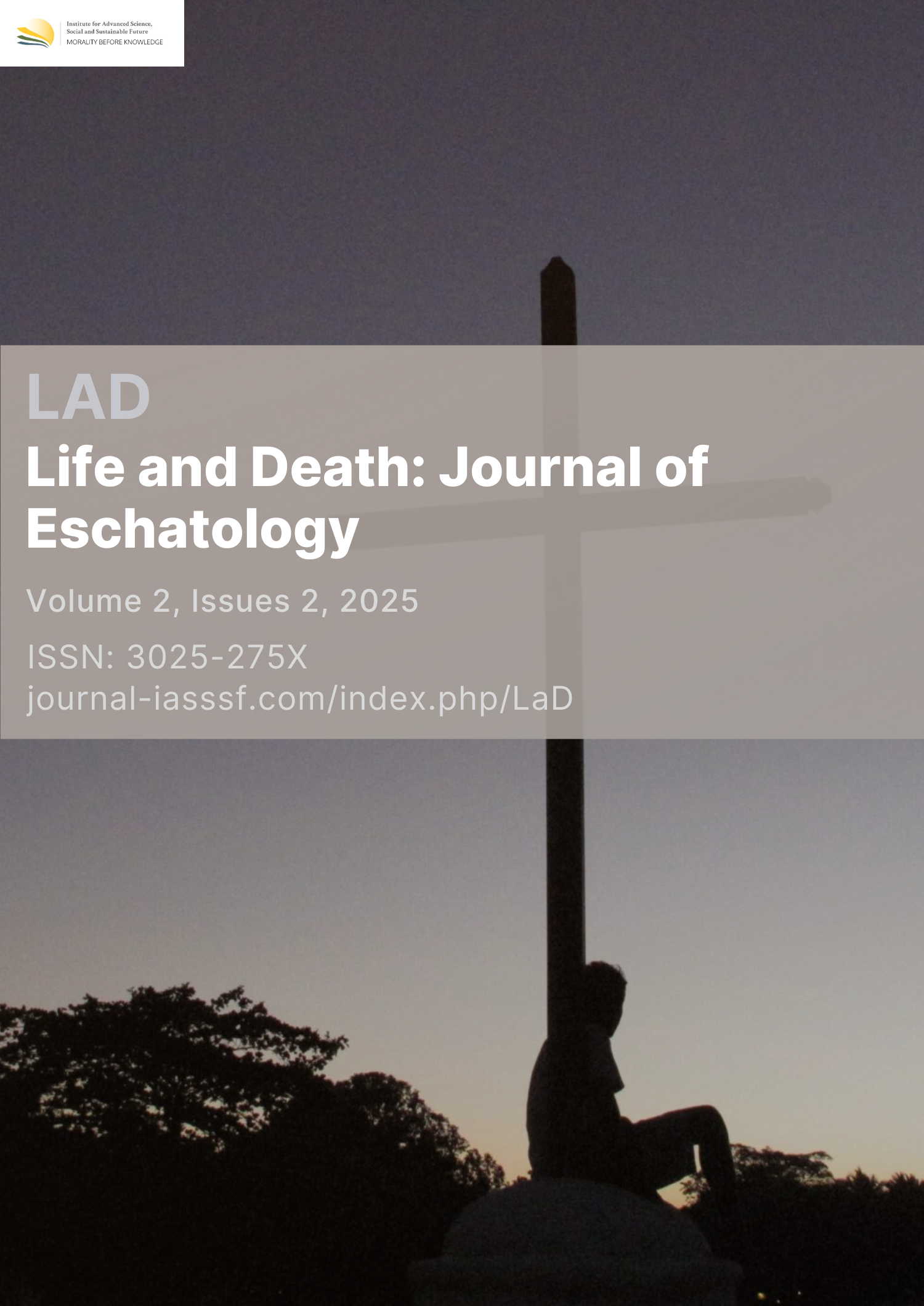Tri murti symbolism in candi prambanan: Revealing the cycle of creation, maintenance, and dissolution in hindu cosmology
DOI:
https://doi.org/10.61511/lad.v2i2.2025.1471Keywords:
cosmic cycle, hindu cosmolog, prambanan, temple, tri murtiAbstract
Background: Prambanan Temple, as a world cultural heritage site, is a silent witness of the Tri Murti worship in Hinduism. Tri Murti, which consists of Brahma (Creator), Vishnu (Preserver), and Shiva (Redeemer), is represented by three main temples in the Prambanan Temple complex, namely Shiva Temple, Vishnu Temple, and Brahma Temple. This research aims to reveal the symbolism of Tri Murti in Prambanan Temple and its relationship with the Hindu cosmological cycle that includes creation, maintenance, and dissolution. Methods: The approach used is qualitative with analytical descriptive method, which examines the architectural structure and arrangement of the three main temples as a representation of the cycle of the universe. Findings: The results show that the arrangement and selection of the three temples illustrate the concept of Hindu cosmology related to the three stages of the life of the universe. This discovery not only confirms the spiritual significance of Prambanan Temple as a place of worship of Tri Murti but also enriches our understanding of Hindu teachings in the context of architecture and space. Conclusions: Tri Murti worship at Prambanan Temple makes an important contribution to the theory of Hindu cosmology and has significant implications for the preservation of Hindu culture and religious practices in Indonesia. Novelty/Originality of this article: This study reveals the unique connection between Tri Murti symbolism and the Hindu cosmological cycle in Prambanan's architecture, which has been rarely explored in previous research.
References
Azra, A. (2001). The origins of Islamic civilization in Indonesia: A history of the sources of Islamization in the Archipelago. Mizan. https://pips.fkip.ulm.ac.id/wp-content/uploads/2021/12/THE-ORIGINS-OF-ISLAMIC-REFORMISMCover.pdf
Bodewitz, H. W. (2019). Vedic cosmology and ethics: Selected studies. In Vedic Cosmology and Ethics. Brill. https://doi.org/10.1163/9789004400139
Braun, V., & Clarke, V. (2006). Using thematic analysis in psychology. Qualitative Research in Psychology, 3(2), 77–101. https://doi.org/10.1191/1478088706qp063oa
Clarke, J. (2005). The role of ritual in Hinduism. Routledge.
Eliade, M. (1969). The sacred and the profane: The nature of religion. Harcourt Brace Jovanovich. https://monoskop.org/images/b/b1/Eliade_Mircea_The_Sacred_and_The_profane_1963.pdf
Eliade, M. (2003). The myth of the eternal return: Cosmos and history. Princeton University Press. http://users.uoa.gr/~cdokou/MythLitMA/Eliade-EternalReturn.pdf
Flood, G. (1996). An introduction to Hinduism. Cambridge University Press.
González-Reimann, L. (2009). Cosmic cycles, cosmology, and cosmography. In Brill's Encyclopedia of Hinduism Online. https://doi.org/10.1163/2212-5019_BEH_COM_1020020
Hardjana, I. (2003). Candi Prambanan: Sejarah dan keagamaan. Universitas Indonesia Press.
Hall, D. (1980). Prambanan: Hindu temples and the cult of Shiva. The University of Sydney Press.
Heine-Geldern, R. (1956). Recent developments in ethnological theory in Europe. University of Pennsylvania Press.
Irawan, M. (2015). Candi Prambanan: Arsitektur dan simbolisme dalam kosmologi Hindu. Jurnal Arsitektur Nusantara, 8(2), 45-59.
Jhunjhunwala, B. (2021). Hindu cosmology in the light of modern psychology. International Journal of Theology, Philosophy and Science, 5(9), 19–52. https://doi.org/10.26520/ijtps.2021.5.9.19-52
Kaisar, M. U. L. (2024). On the cosmologies of Vedic, Sankhya and Vedantic philosophies. International Journal of Social Sciences and Humanities Invention, 11(4), 8123-8126. https://doi.org/10.18535/ijsshi/v11i04.03
Kaur, J., Verma, N., & Reddy, T. B. C. (2024). History and theory of design in traditional temple architecture of India. International Journal for Multidisciplinary Research, 6(3), 1-13. https://www.ijfmr.com
Kramrisch, S. (1946). The Hindu temple: Its meaning and forms. Motilal Banarsidass. https://archive.org/details/in.ernet.dli.2015.282158/page/n15/mode/2up
Krom, N. (1923). The architecture of the Hindu temple in Java. Dutch East Indies Archaeological Society.
Macdaniel, D. A. (2015). Prambanan: Cultural significance and its Hindu cosmology. Journal of Southeast Asian Religious Studies, 21(1), 78–95. https://doi.org/10.1007/s13521-015-0149-6
Mendoza, J. M. (2021). Cosmogony in progress: The creation myths from Ṛgvedic to Brāhmanic texts. In Narrating the beginnings (pp. 5–22). Springer. https://doi.org/10.1007/978-3-030-64850-5_1
Olivelle, P. (2004). The laws of Manu. Oxford University Press.
Ritzer, G. (2004). The McDonaldization of society. Pine Forge Press.
Rohit, P. (2019). Peran Siwa dalam kosmologi Hindu. Journal of Hindu Studies, 12(4), 113–127.
Ratni, N. P. (2020). Fungsi Dan Keistimewaan Makna Candi Prambanan Bagi Umat Hindu Di Indonesia. Jurnal Penelitian Agama Hindu, 4(4), 200-212. https://jayapanguspress.penerbit.org/index.php/JPAH/article/view/1224
Saraswati, A. (2017). Kosmologi Hindu dan Tri Murti: Pemujaan di Candi Prambanan. Journal of Indonesian Culture, 8(2), 45-59. https://doi.org/10.20473/jic.v8i2.2017.45-59
Smith, H. (2009). The world's religions. HarperOne. https://fbcclassroom.com/wp-content/uploads/2022/07/The-Worlds-Religions-Our-Great-Wisdom-Traditions-by-Huston-Smith-z-lib.org_.pdf
Soekmono, R. (1981). Candi: Pengantar sejarah kebudayaan Indonesia. Yayasan Kanisius.
Surpi, N. K. (2020). Śivagrha (Prambanan Temple) as an Archetype of Hindu Theology in Nusantara (An Endeavor to Discover Hindu Theological Knowledge through Ancient Temple Heritage). Analisa: Journal of Social Science and Religion, 5(1), 107-122. https://doi.org/10.18784/analisa.v5i1.1024
Surpi, N. K., Widiana, I. G. P. G., & Marselinawati, P. S. (2023). Śivagṛha: religious harmonization and the concept of unity in diversity. Life and Death: Journal of Eschatology, 1(1). https://doi.org/10.61511/lad.v1i1.2023.192
Surpi, N. K., & Ratni. (2023). Śivagrha Babon Teologi Hindu Nusantara. Dharma Pustaka Utama.
Surpi, N. K., Wika, I. M., & Widyastuti, N. P. (2024). Teologi Parabrahman: Candi Prambanan Pusat Ibadah Hindu Dunia & Episentrum Spiritualitas. PT. Dharma Pustaka Utama.
Zimmer, H. (1951). Philosophies of India. Princeton University Press.
Downloads
Published
How to Cite
Issue
Section
Citation Check
License
Copyright (c) 2025 I Made Wika, Gautam Kumar Jha, Siluh Nyoman Seriadi

This work is licensed under a Creative Commons Attribution 4.0 International License.
















